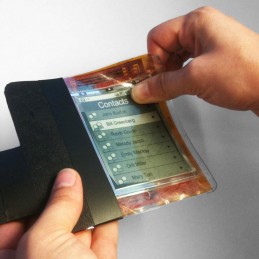Flexible paper computer morphs into smartphone or tablet
May 5, 2011
PaperPhone, an interactive computer that looks, feels, and operates like a small sheet of interactive paper, has been developed by engineers at Queen’s University Human Media Lab.
The flexible paper computer can be bent into a cell phone, flipped like a book, or written upon with a pen. It does everything a smartphone does, like store books, play music, and make phone calls.
But its display consists of a 9.5 cm diagonal thin film flexible E Ink display. The flexible form of the display makes it much more portable that any current mobile computer: it will shape to your pocket.
The ability to store and interact with documents on larger versions of these light, flexible computers means offices will no longer require paper or printers, say the engineers. They say the invention heralds a new generation of computers that are super-lightweight, thin-film, and flexible. The computers use no power when users are not interacting with them. When users are reading, they don’t feel like they’re holding a sheet of glass or metal.
The new thin-film paper computer will be unveiled May 10 at the Association of Computing Machinery’s CHI 2011 (Computer Human Interaction) conference in Vancouver.
